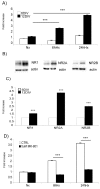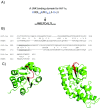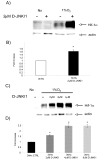JNK contributes to Hif-1alpha regulation in hypoxic neurons
- PMID: 20110876
- PMCID: PMC6256924
- DOI: 10.3390/molecules15010114
JNK contributes to Hif-1alpha regulation in hypoxic neurons
Abstract
Hypoxia is an established factor of neurodegeneration. Nowadays, attention is directed at understanding how alterations in the expression of stress-related signaling proteins contribute to age dependent neuronal vulnerability to injury. The purpose of this study was to investigate how Hif-1alpha, a major neuroprotective factor, and JNK signaling, a key pathway in neurodegeneration, relate to hypoxic injury in young (6DIV) and adult (12DIV) neurons. We could show that in young neurons as compared to mature ones, the protective factor Hif-1alpha is more induced while the stress protein phospho-JNK displays lower basal levels. Indeed, changes in the expression levels of these proteins correlated with increased vulnerability of adult neurons to hypoxic injury. Furthermore, we describe for the first time that treatment with the D-JNKI1, a JNK-inhibiting peptide, rescues adult hypoxic neurons from death and contributes to Hif-1alpha upregulation, probably via a direct interaction with the Hif-1alpha protein.
Figures






Similar articles
-
Biochemical and molecular analysis of the interaction between ERK2 MAP kinase and hypoxia inducible factor-1α.Int J Biochem Cell Biol. 2011 Nov;43(11):1582-90. doi: 10.1016/j.biocel.2011.07.007. Epub 2011 Jul 22. Int J Biochem Cell Biol. 2011. PMID: 21807114
-
Temporal Rac1 - HIF-1 crosstalk modulates hypoxic survival of aged neurons.Brain Res. 2016 Jul 1;1642:298-307. doi: 10.1016/j.brainres.2016.03.025. Epub 2016 Mar 24. Brain Res. 2016. PMID: 27018294
-
c-Jun NH2-terminal kinase activation contributes to hypoxia-inducible factor 1alpha-dependent P-glycoprotein expression in hypoxia.Cancer Res. 2004 Dec 15;64(24):9057-61. doi: 10.1158/0008-5472.CAN-04-1919. Cancer Res. 2004. PMID: 15604272
-
The role and regulation of hypoxia-inducible factor-1alpha expression in brain development and neonatal hypoxic-ischemic brain injury.Brain Res Rev. 2009 Dec 11;62(1):99-108. doi: 10.1016/j.brainresrev.2009.09.006. Epub 2009 Sep 25. Brain Res Rev. 2009. PMID: 19786048 Review.
-
Impaired Neovascularization in Aging.Adv Wound Care (New Rochelle). 2020 Mar 1;9(3):111-126. doi: 10.1089/wound.2018.0912. Epub 2020 Jan 24. Adv Wound Care (New Rochelle). 2020. PMID: 31993253 Free PMC article. Review.
Cited by
-
Molecular characterization and expression analysis of three hypoxia-inducible factor alpha subunits, HIF-1α, -2α and -3α in hypoxia-tolerant Indian catfish, Clarias batrachus [Linnaeus, 1758].Mol Biol Rep. 2013 Oct;40(10):5805-15. doi: 10.1007/s11033-013-2685-1. Epub 2013 Sep 25. Mol Biol Rep. 2013. PMID: 24065526
-
Presynaptic c-Jun N-terminal Kinase 2 regulates NMDA receptor-dependent glutamate release.Sci Rep. 2015 Mar 12;5:9035. doi: 10.1038/srep09035. Sci Rep. 2015. PMID: 25762148 Free PMC article.
-
c-Jun N-terminal kinase signaling in cellular senescence.Arch Toxicol. 2023 Aug;97(8):2089-2109. doi: 10.1007/s00204-023-03540-1. Epub 2023 Jun 19. Arch Toxicol. 2023. PMID: 37335314 Review.
-
Combined antiapoptotic and antioxidant approach to acute neuroprotection for stroke in hypertensive rats.J Cereb Blood Flow Metab. 2013 Aug;33(8):1215-24. doi: 10.1038/jcbfm.2013.70. Epub 2013 May 1. J Cereb Blood Flow Metab. 2013. PMID: 23632970 Free PMC article.
-
Evidence that collaboration between HIF-1α and Notch-1 promotes neuronal cell death in ischemic stroke.Neurobiol Dis. 2014 Feb;62:286-95. doi: 10.1016/j.nbd.2013.10.009. Epub 2013 Oct 16. Neurobiol Dis. 2014. PMID: 24141018 Free PMC article.
References
-
- Lu T., Pan Y., Kao S.Y., Li C., Kohane I., Chan J., Yankner B.A. Gene regulation and DNA damage in the ageing human brain. Nature. 2004;429:883–891. - PubMed
Publication types
MeSH terms
Substances
LinkOut - more resources
Full Text Sources
Research Materials

